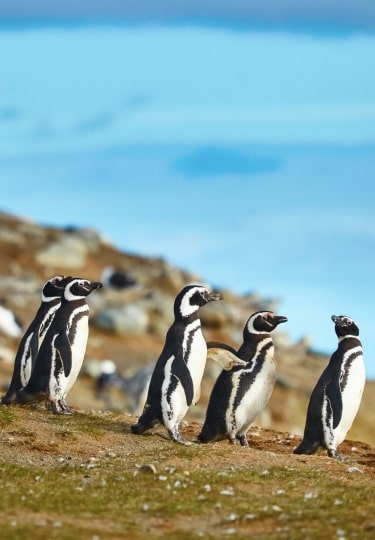With their dapper tuxedos and comical waddles, there’s just something about penguins that make them so very endearing to us. Whether it was a film that helped inspire your love for penguins, or perhaps an encounter with their charismatic ways at a local zoo, you’re not alone: Penguins are about as popular as they come in the bird world.
Happily, you don’t need to venture to the farthest reaches of the Antarctic to come face to face with these friendly yet flightless aquatic birds. There are plenty of penguins to be found throughout the Southern Hemisphere.
Notably, you’ll find penguins in South America, from the frigid southernmost tip of Patagonia to as far north as the Galápagos Islands. These beautiful birds can be seen breeding and cavorting in the wild, if you know where to look.
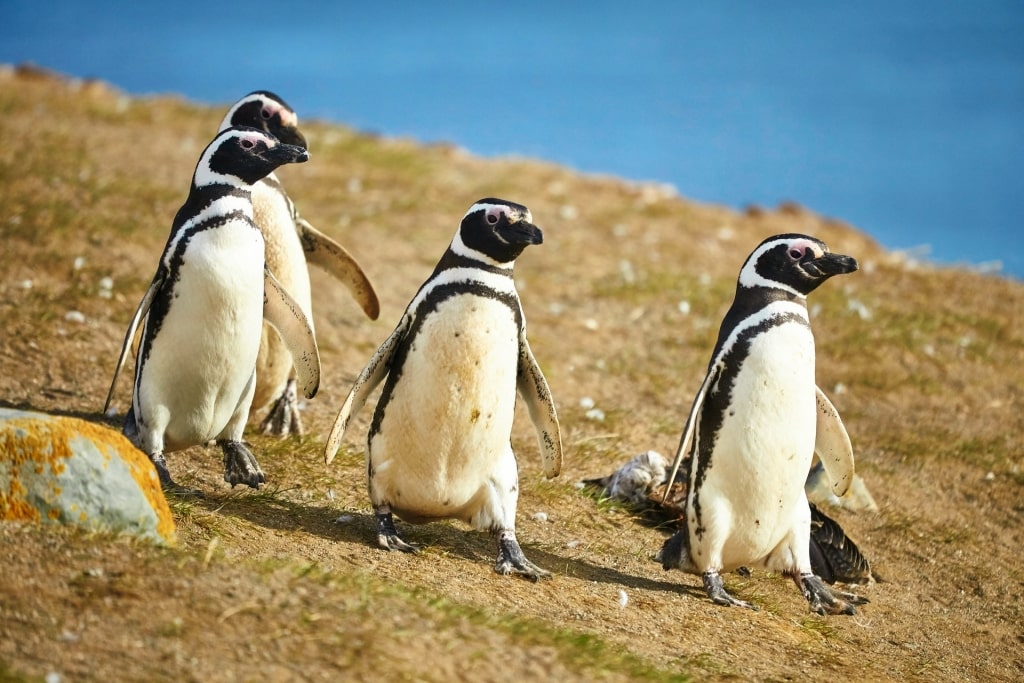
Magdalena Island in Patagonia, Chile
Here are some of the best places in South America to spot penguins.
The Galápagos Islands
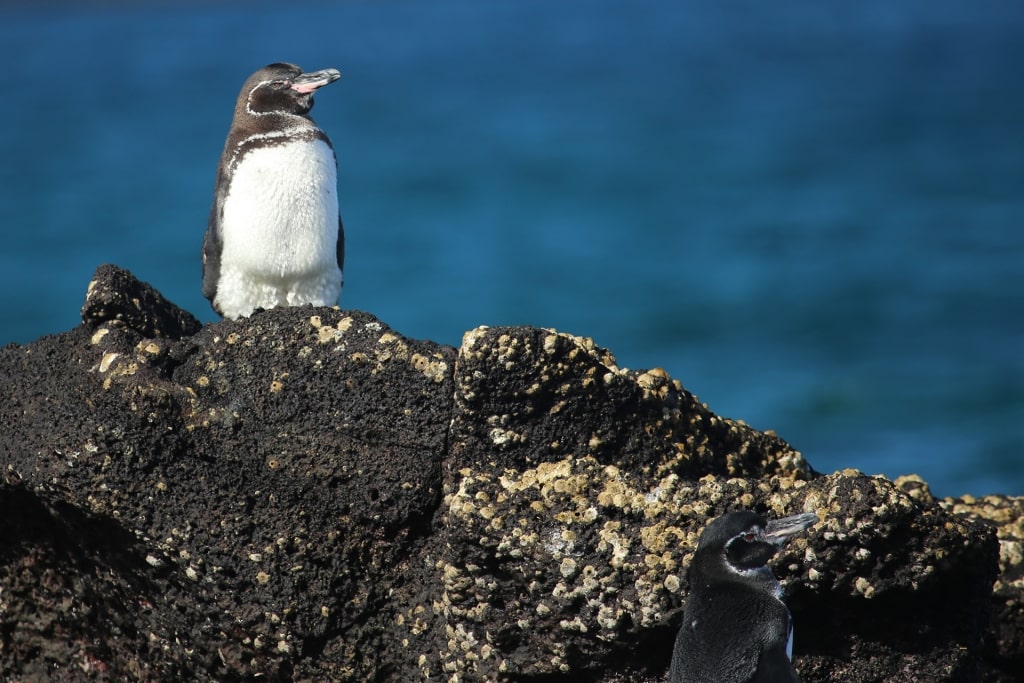
Galápagos
Few destinations excite wildlife enthusiasts like Ecuador’s Galápagos Islands, and for good reason: There are so many exceptional Galápagos animals to observe in the wild here—from the giant Galápagos tortoise to the blue-footed booby. But for penguin lovers, it’s all about the islands’ endemic Galápagos penguin, which can only be found in this environmental oasis.
The Galápagos penguin’s residence in the island chain is a geographic anomaly, as they are the only penguins to live north of the equator, a region that typically falls far outside of penguin territory. However, the cool, nutrient-rich waters of the Humboldt and Cromwell currents here make it possible for them to thrive.
Indeed, Galápagos penguins are the northernmost species in the world and delight with their small size—they are the second smallest type of penguin (after the Little Penguin, or Fairy Penguin), measuring in under 20 inches in height, on average.
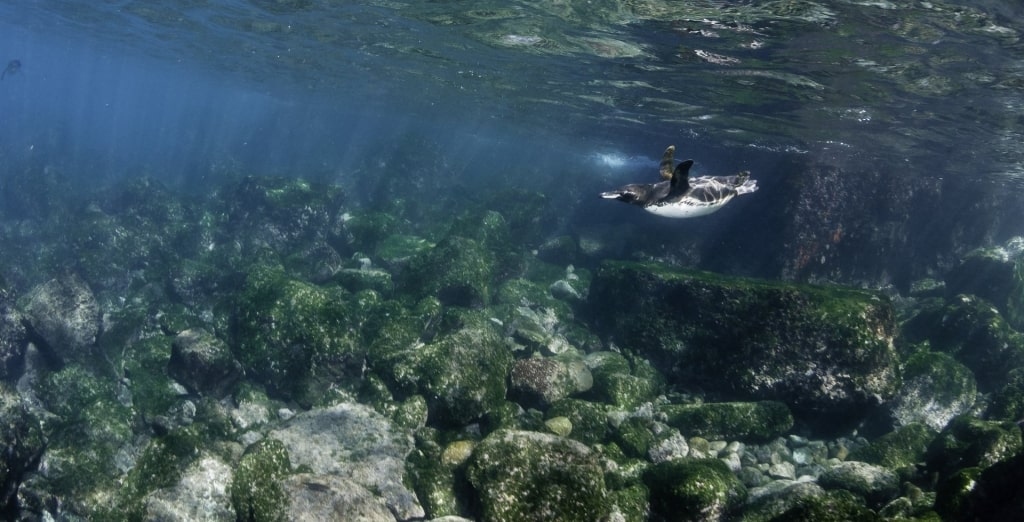
Punta Vicente Roca, Galápagos
To the delight of most visitors, it’s possible to swim, snorkel, and even dive with penguins while here—one of the few places on the planet where such an experience can take place. Just don’t expect to win an underwater race with them, as these penguins can reach swim speeds as fast as 15 miles per hour. However, many visitors are perfectly content to view them by boat tours, too.
Bonus: Unlike other penguin species who migrate throughout the year in South America, it’s possible to view Galápagos penguins year-round.
Read: Best Countries to Visit in South America
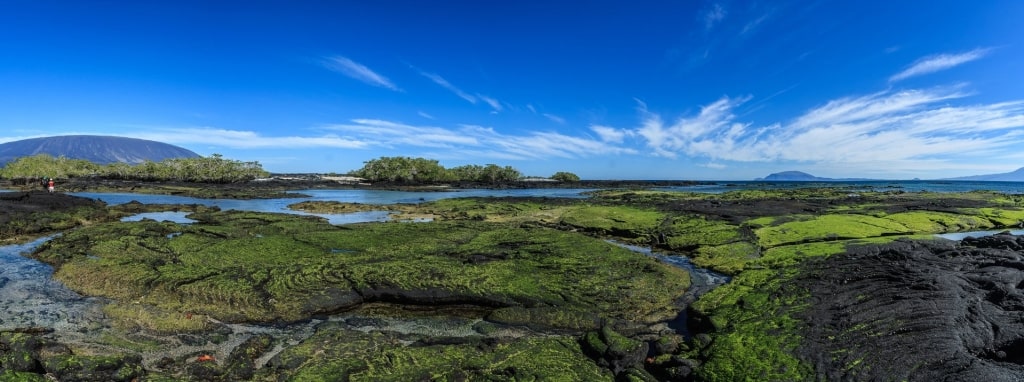
Fernandina Island, Galápagos
With just about 1,200 left in the world, the Galápagos penguin is a rare and endangered species. There are two prime spots for viewing them in the island chain.
Look out for penguins sunning themselves, or having a swim just offshore, on two of the western islands, like Fernandina Island’s rocky shores or on the west coast of Isabela Island. The penguins like to breed in the crevices and caves of the old lava flows found on the two volcanic islands.
Look around and you might spot giant tortoises, marine iguanas, sea lions, sea turtles, rays, and tons of other seabirds like pelicans, herons, and cormorants, too.
Magdalena Island, Chile
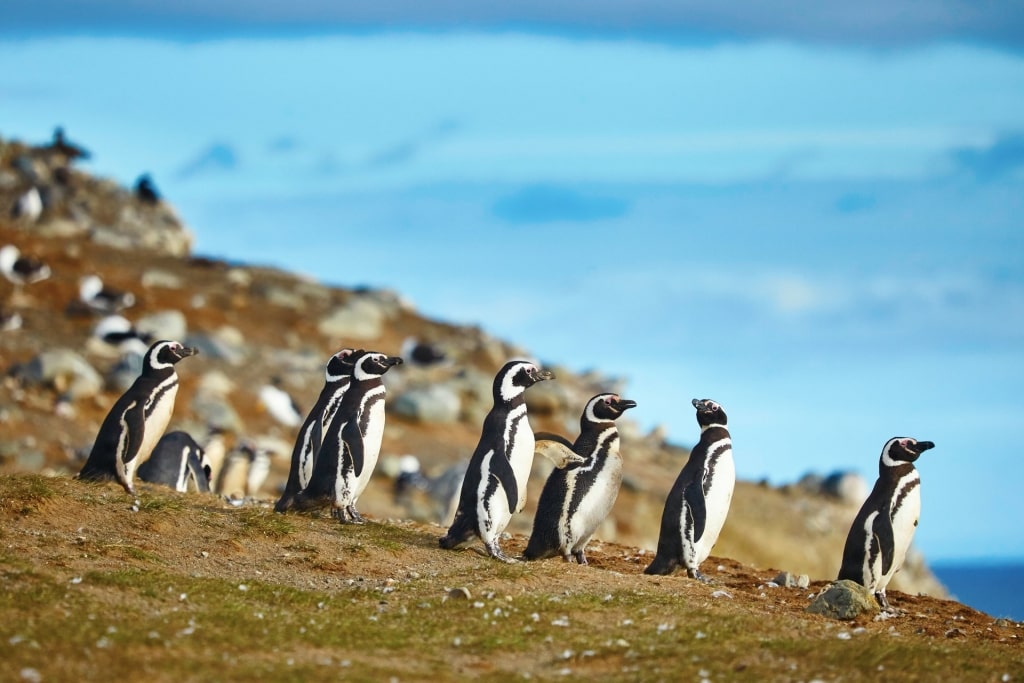
Magdalena Island, Chile
Part of the Los Pingüinos Natural Monument, a protected area in Patagonia, Magdalena Island is home to a massive colony of Magellanic penguins. With an estimated 60,000 breeding pairs, it’s Chile’s largest penguin colony.
But there’s more than just penguins here. Look out for other island visitors like sea lions, elephant seals, and cormorants while in the surrounding waters, breaching dolphins and whales have also been known to appear. Just note you won’t find any humans here other than fellow visitors since Magdalena Island is uninhabited by people.
Magdalena Island in the Magellan Strait is reached via a boat ride from the Chilean port city of Punta Arenas, which is located about 22 miles away.
Punta Tombo, Argentina
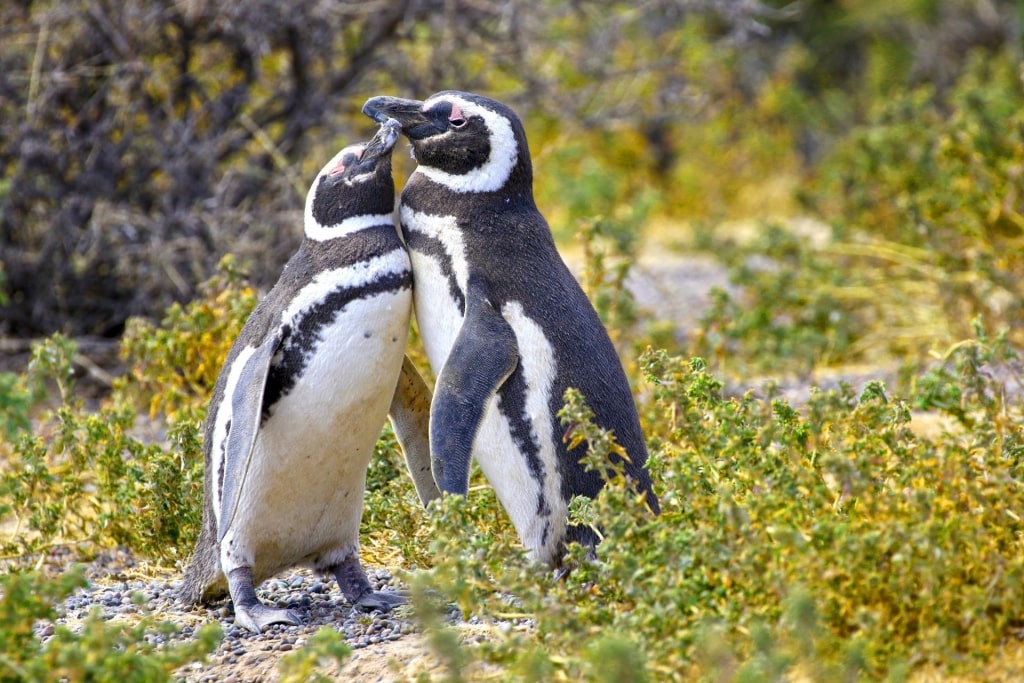
Punta Tombo, Argentina
The Punta Tombo peninsula on the Atlantic coast, within a day trip distance of Puerto Madryn, offers access to the largest colony of Magellanic penguins in South America and the world, as hundreds of thousands of penguins come here to roost each year.
Upon entrance to the protected coastal nature reserve—which is situated about halfway down Argentina’s eastern coast—you’ll be able to walk among the birds, as they make way to and from the sea, tending to their young at certain times of the year.
As you stroll along walkways through the colony, it’s easy to see why this so-called “penguin paradise” is one of the best spots to see these majestic birds not just in South America, but in the world.
Ushuaia, Beagle Channel, Argentina
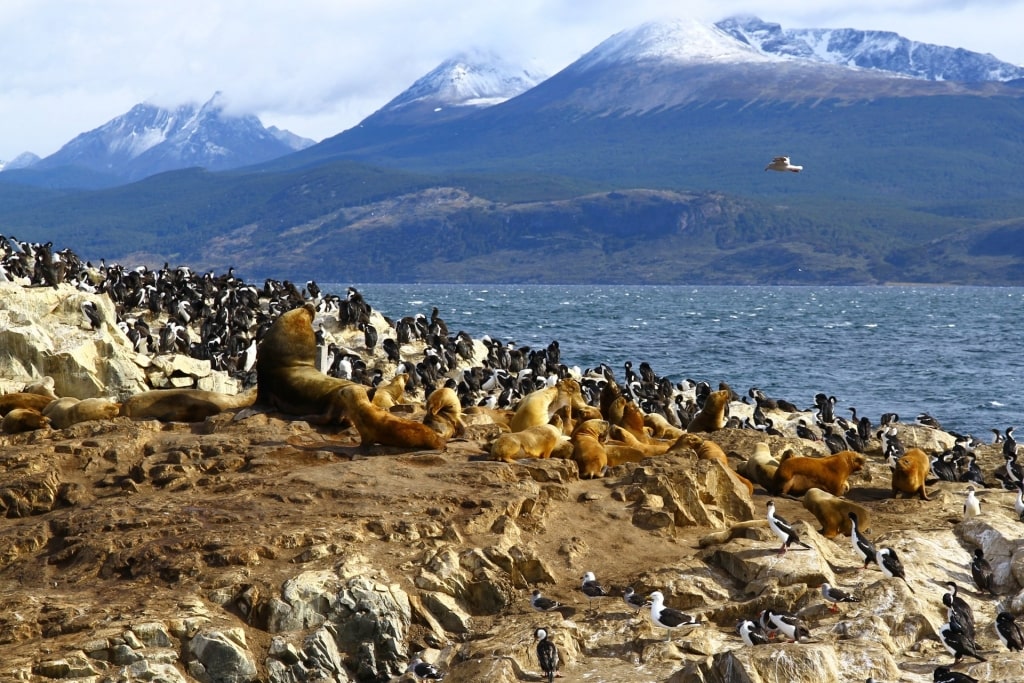
Ushuaia in Beagle Channel, Argentina
The Beagle Channel, accessible from Ushuaia—the southernmost city in the world located in the Tierra del Fuego archipelago—is filled in with islands that are havens for penguin colonies.
Tiny Hammer Island is one standout. Known for its Magellanic penguins, you can even find some Gentoos here.
Another top spot is Martillo Island, aka “Penguin Island,” which is home to thousands of Magellanic penguins along with a small colony of Gentoos. If you’re exceptionally lucky, you could possibly catch a glimpse of the rarer King penguins that occasionally make their way here, too.
Keep your eyes peeled for other types of wildlife around the Beagle Channel, as there are sea lions and dolphins aplenty in the surrounding Beagle Channel waters and other seabirds like cormorants, herons, and oystercatchers.
Falkland Islands
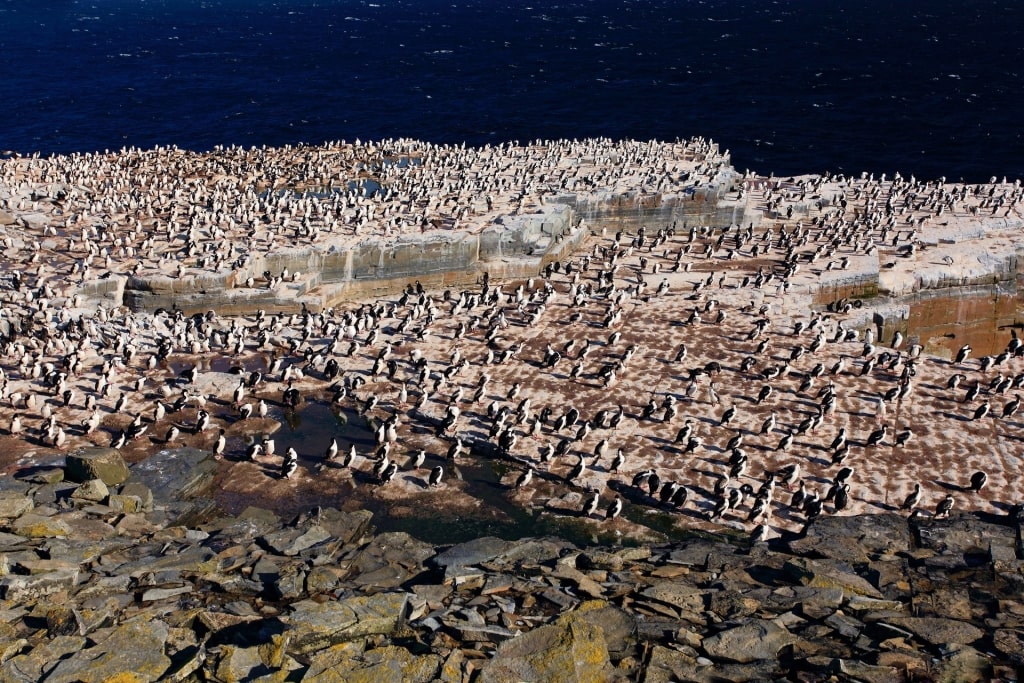
Falkland Islands
The little-touristed Falkland Islands—a British overseas territory set about 300 miles east of Argentina—claims a population of penguins that far outnumbers human residents (the human population is about 3,000, while the penguin population can reach as high as a million in the summer months).
But for penguin lovers, the journey to the remote, sub-Antarctic archipelago is well worth it, since a whopping five penguins species can be found here: King, Southern Rockhopper, Magellanic, Macaroni, and Gentoo penguins—with the Gentoo population coming in as the world’s largest.
The Falklands are a surprising terrain for these birds—instead of snowy landscapes, here, you’ll find penguins frolicking on sandy beaches and wandering through sheep paddocks and grasslands.
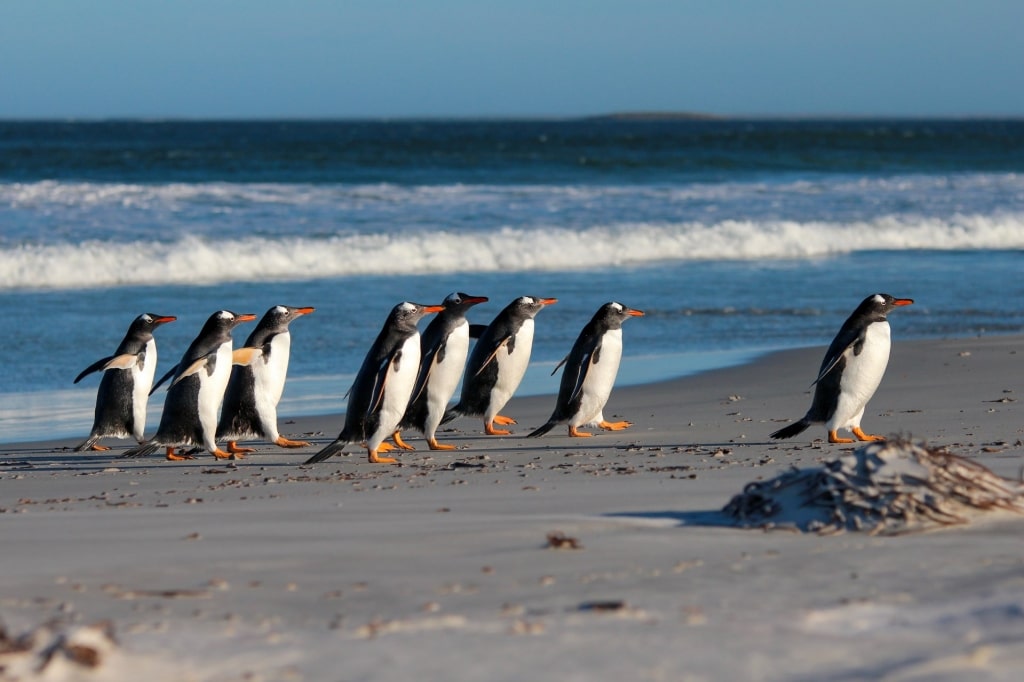
Bertha’s Beach, Falkland Islands
Optimal spots for viewing can be reached via Port Stanley, the islands’ capital. Bertha’s Beach, a working sheep farm, is one fantastic option that is home to 400 pairs of Gentoo penguins.
The bird watcher’s paradise at Volunteer Point is another stellar destination, where over 2,000 penguins, spanning three species—King, Gentoo, and Magellanic—frolic on the white-sand beaches.
It marks one of the world’s most accessible King penguin colonies, even with the off-roading ATV ride required to get there. Staring down the mammoth penguins that can reach heights of three feet or more is an unforgettable experience.
Of course, penguins aren’t all that you’ll find in the Falklands. Look out for dozens of other species of South American birds that have been spotted in the archipelago, too, like albatross, petrels, cormorants, Oystercatchers, herons, and more.
Estancia San Lorenzo, Argentina
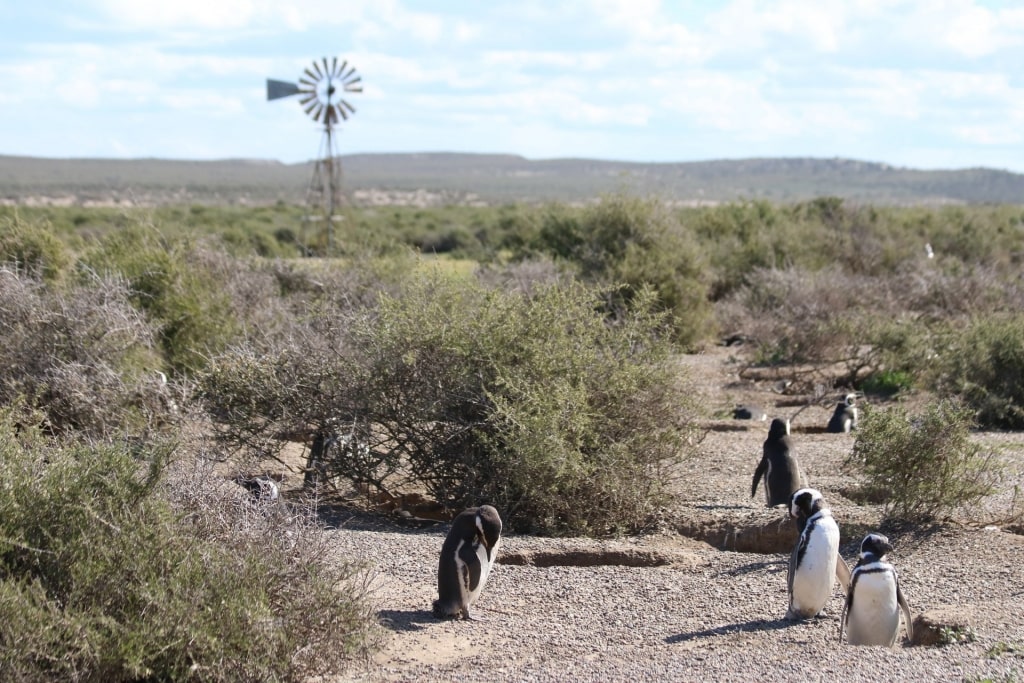
Estancia San Lorenzo, Argentina
This picturesque Patagonian ranch on the Valdés Peninsula is another day-trip possibility from the city of Puerto Madryn. On this traditional Patagonian sheep ranch, a massive colony of Magellanic penguins counts at more than two hundred thousand pairs.
A designated walkway passes through the penguin zone, pairing views of the beloved birds with lovely landscapes of beaches, sand dunes, and working farmland, while active sea life, like elephant seals and seabirds, abounds.
What kind of penguins live in South America?
Of the world’s seventeen penguin species, there are at least seven types of penguins in South America, including:
Magellanic penguins
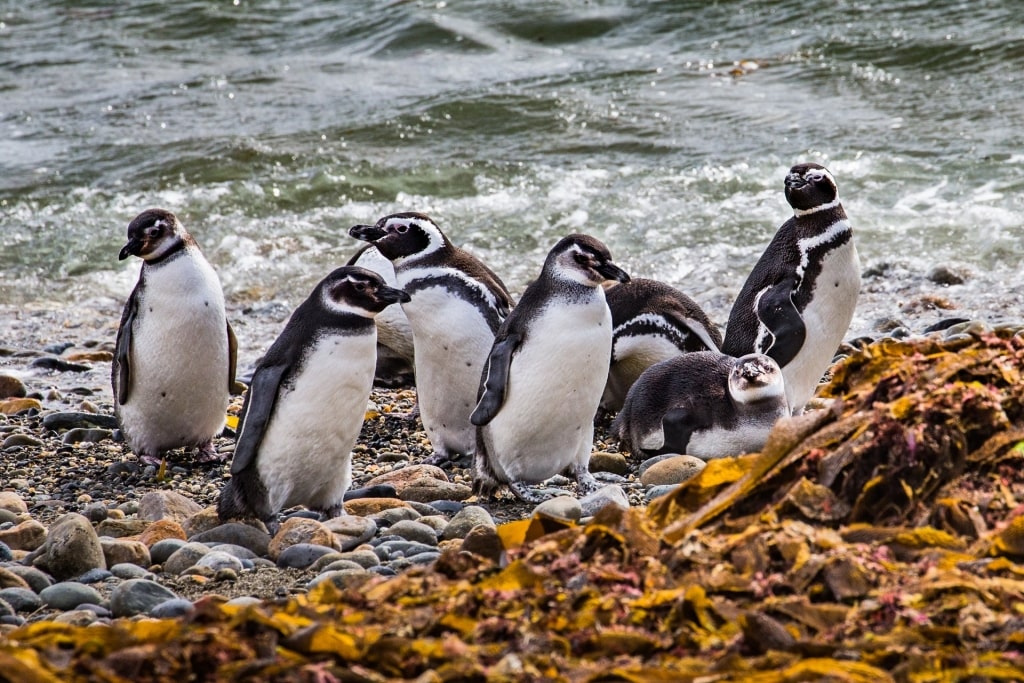
Magellanic penguins
Averaging heights of 24 to 30 inches, Magellanic penguins take their name from Portuguese explorer Ferdinand Magellan, who spotted the species during his South American expeditions.
These migratory penguins are prolific on the continent and can be found in Argentina, Chile, and the Falkland Islands, on both the Atlantic and Pacific coasts. With typical black-and-white coloring, their distinctive markings are in the black bands that form rings around their white bellies and necks.
Humboldt penguins
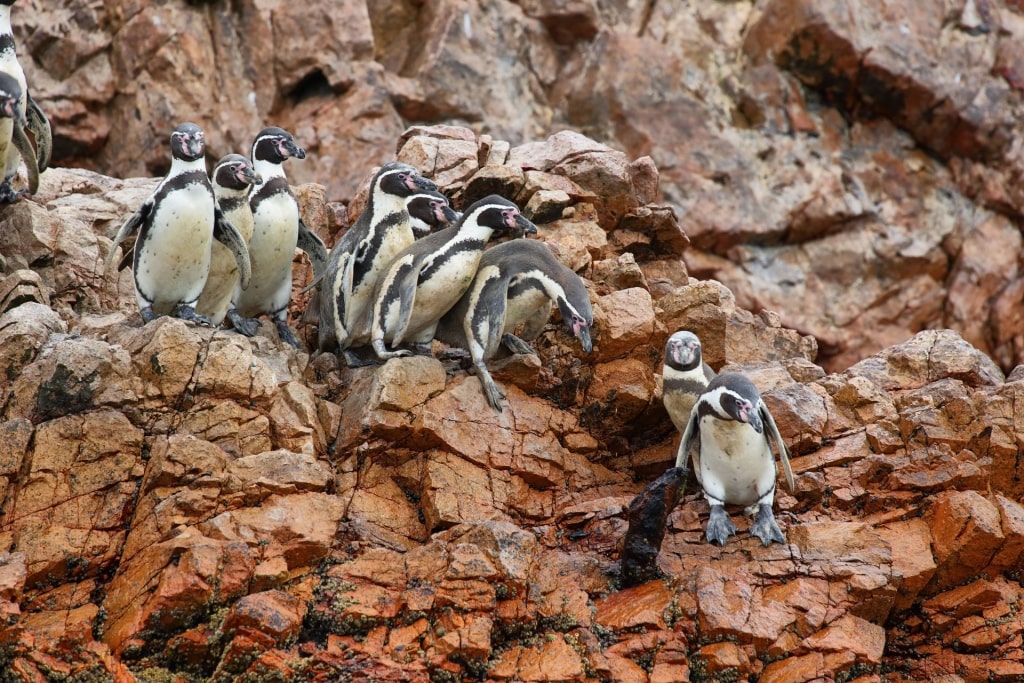
Humboldt penguins
Humboldt penguins mostly live on the western coast of South America, from Chile all the way up to Peru. They are named after the cold-water current that they swim in (the Humboldt Current) and are close cousins to Magellanic penguins. Averaging about two feet in height, they’re noted for the white border around their eyes.
Southern Rockhopper penguins
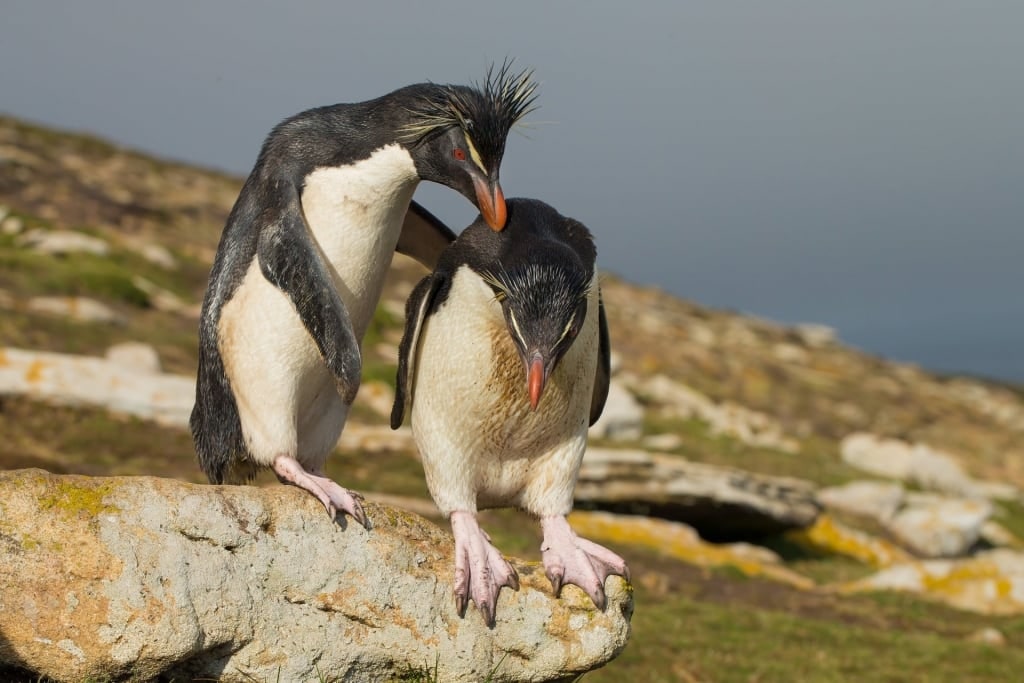
Southern Rockhopper penguins
The smaller Southern Rockhopper, which averages about 20 inches in height and around five or six pounds in weight, is known for its red eyes, pink-webbed feet, and crest of spiky yellow plumage.
True to its name, these birds tend to hop from spot to spot (or rock to rock), foregoing the waddling that’s commonplace with other penguin species. Colonies of these penguins in South America are found in Argentina and Chile’s coastal isles, as well as in the Falkland Islands.
Gentoo penguins
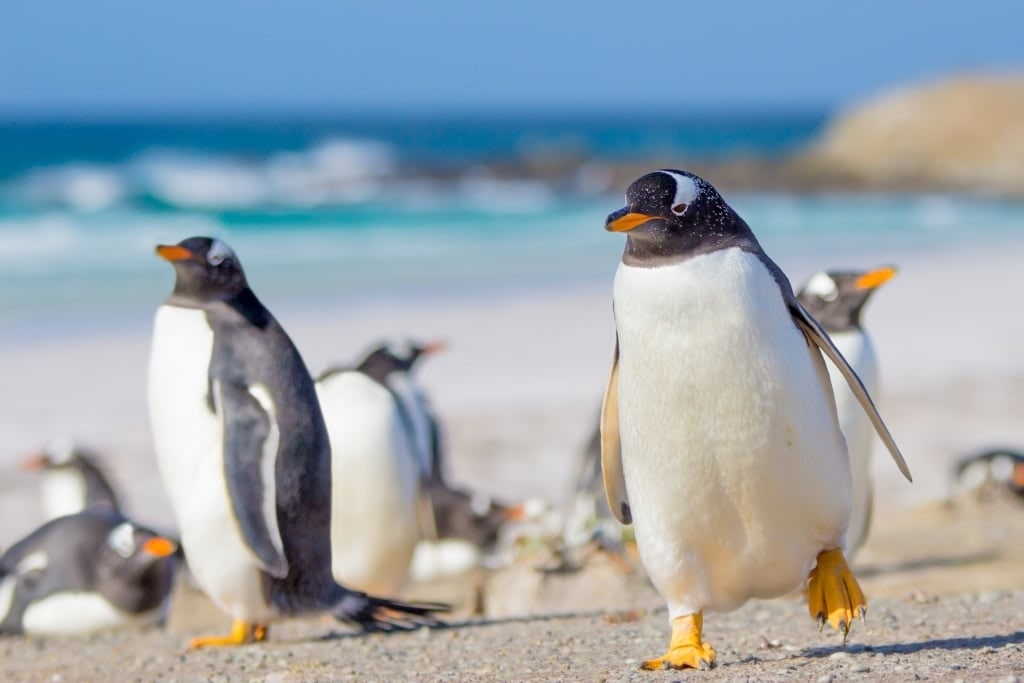
Gentoo penguins
Reaching about 2.5 feet in height, Gentoo penguins are known for their white feather caps and bright orange beaks and feet. The Falkland Islands are home to the largest population of Gentoos in the world.
Galápagos penguins
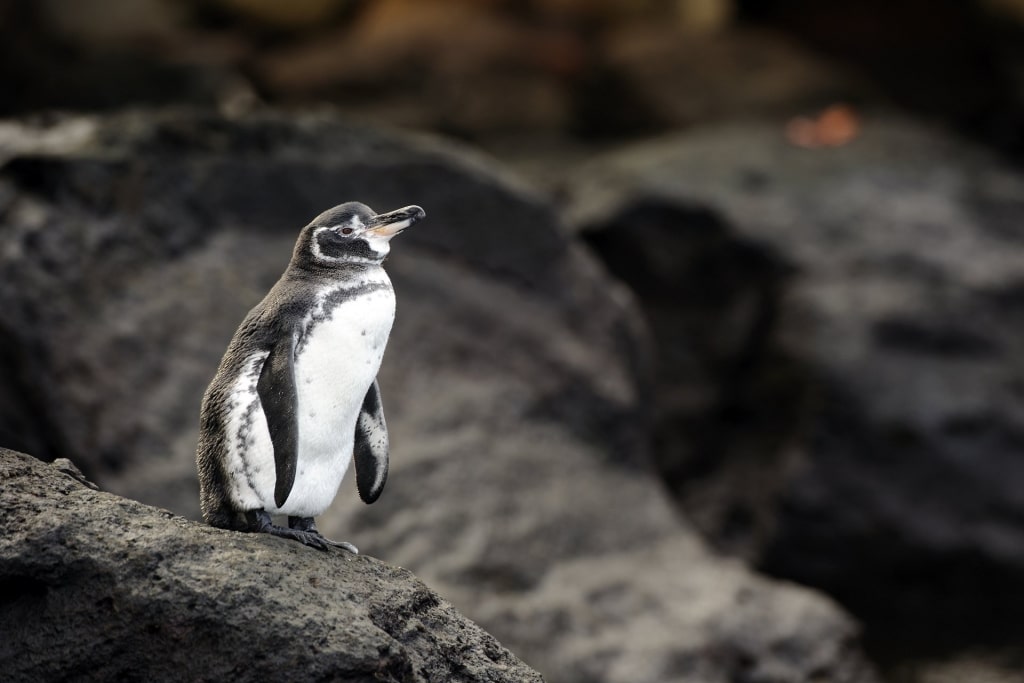
Galápagos penguin
The tiny Galápagos penguin—averaging about nineteen inches in length and weighing just over five pounds—is the only penguin species to be found north of the equator.
King penguins
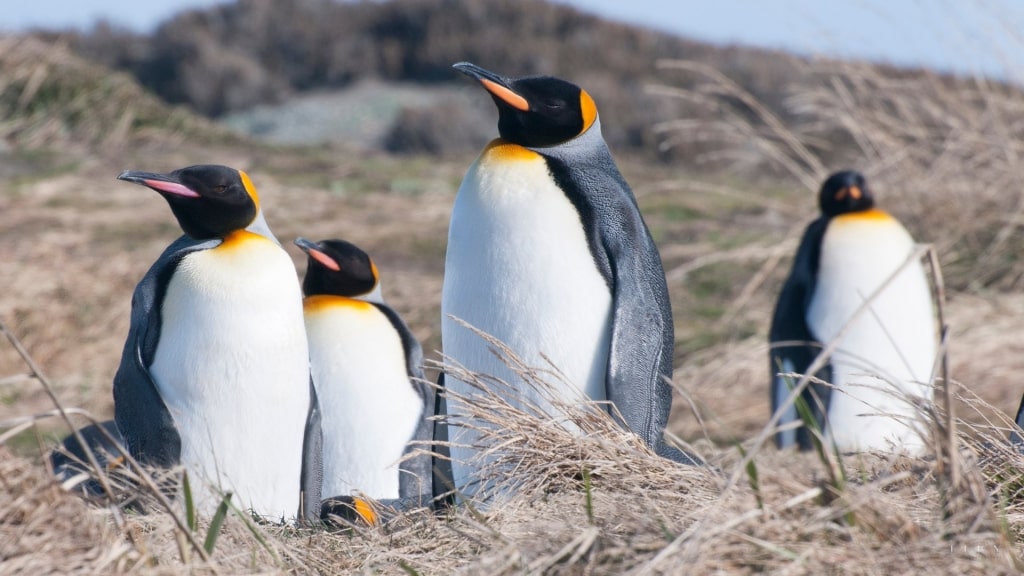
King penguins
This regal bird is the world’s second-largest penguin species, second only to the Antarctic’s Emperor penguin, and regularly topping three feet in height. They’re distinguished by the striking splashes of yellow and orange plumage around their chest and head. The Falkland Islands are one particularly good spot to view them beyond the Antarctic.
Macaroni penguin
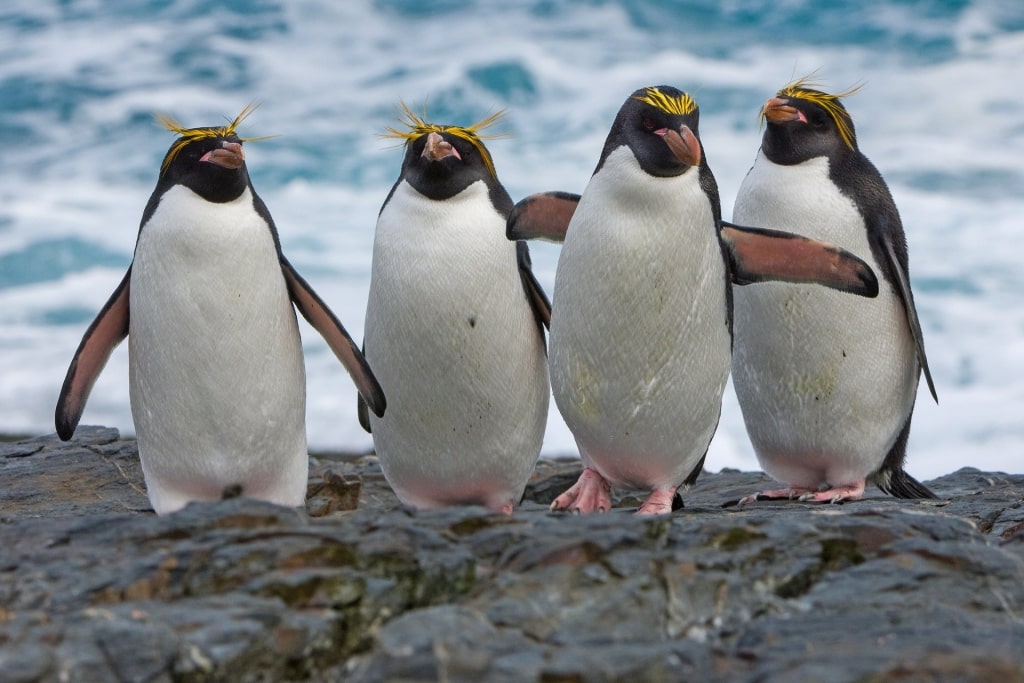
Macaroni penguins
Known for its bright yellow crest, this elusive penguin—averaging heights of two-and-a-half feet—can be found (with a little luck) in southern Chile, Argentina, and the Falkland Islands.
When’s the best time to visit South America to see penguins?
You’ll want to plan your trip during the warmer South American months, particularly from November through March, when penguins come ashore to breed, nest, and tend to their young chicks.
Read: How To Spot Marine Mammals From a Cruise Ship
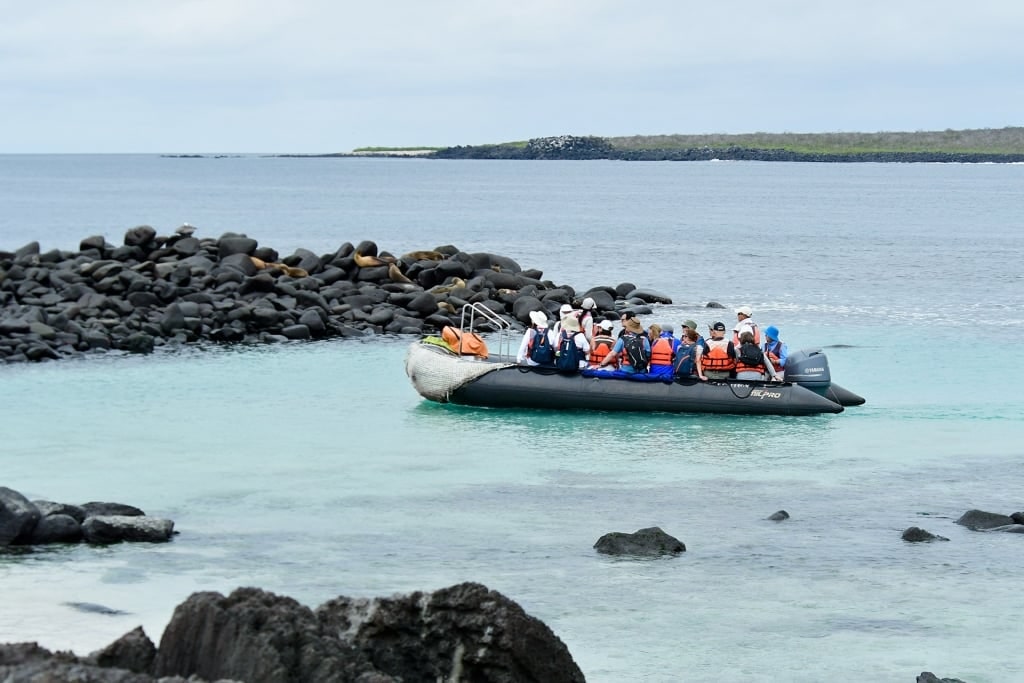
Galápagos
You might not have the wings-turned-fins of a penguin, but that shouldn’t keep you from exploring the seven seas. An unforgettable South America cruise vacation with Celebrity Cruises is just the ticket for an exciting voyage.
Browse cruise itineraries on our website to start planning your South American vacation today.
